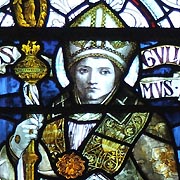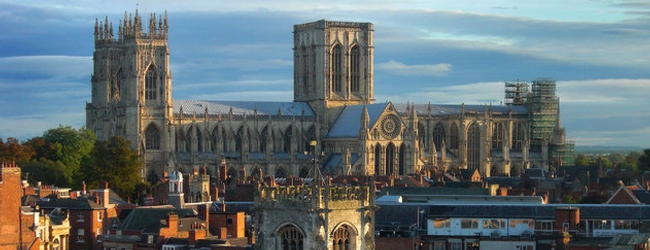
Summary : St William of York, the “on and off” archbishop of York twice in the period of England’s history known as the Anarchy (1135-54), when the armies of two cousins – Stephen of Blois and Empress Matilda – were fighting for the monarchy. He is commemorated in both the crypt and one of the huge windows of the York Minster. (The image below left )- is taken from that window – shows William crossing over the Ouse bridge.
Patrick Duffy tells his story.
Political Football
 William Fitzherbert had a turbulent ecclesiastical career. He became a political football between two factions squabbling for the throne of England during a period the 12th century known as the Anarchy (1135-54).
William Fitzherbert had a turbulent ecclesiastical career. He became a political football between two factions squabbling for the throne of England during a period the 12th century known as the Anarchy (1135-54).
Context of the Anarchy
William’s mother Emma was half-sister of Stephen of Blois, who claimed the throne of England after the death of Henry I in 1135, even though Henry had named his daughter, the Empress Matilda, (also Stephen’s first cousin) as his successor. Both contestants were grandchildren of William the Conqueror. The English barons and Pope Innocent II favoured Stephen, while the Normans – largely based in France, but also now in England – favoured Matilda.
Eventual outcome of the Anarchy
(Matilda had been married to the Holy Roman Emperor Henry V. He died and she later married Geoffrey of Anjou, by whom she had three sons, the eldest of whom eventually – 1154 – became Henry II of England).
First period as Archbishop (1143-47)
William was treasurer of York Minster when the archbishop died there in 1141. He had the majority of the chapter vote, along with Stephen’s support, in the election for archbishop. However, the archbishop of Canterbury, Theobald of Bec, a supporter of the claims of the Empress Matilda, refused to recognise William’s election or to consecrate him. So Stephen’s brother, Henry of Winchester, did so, without papal approval. The clergy of York, however, were quite happy with him, seeing him as kind-hearted, generous to the poor and personally austere.
Election Disputed and a rival Appointed
The disappointed minority in the election had supported the Cistercian abbot of Fountains, Henry Murdac. The Yorkshire Cistercians, with the help of Bernard of Clairvaux, accused William of simony, unchastity and intrusion, and appealed to the Pope.
Cistercian and Papal Interference
The papacy itself was in dispute at the time and when it was resolved, the new pope, a Cistercian, Eugenius III, suspended William, deposed him, and appointed Henry Murdac. But when Henry Murdac tried to take possession of the see, the clergy of York refused to admit him. So although he was nominally archbishop from 1147-53 he retired to Beverley.
William in Sicily and at Winchester
During this time, William first took refuge with his friend the King of Sicily. He later came back to England and went to Winchester where his uncle was bishop. Here he lived devoutly as a monk until 1153. By then the civil war was settled and Bernard of Clairvaux, Pope Eugenius and Henry Murdac had all died.
The Anarchy (1135-54)
In the meantime, battles were being waged on the ground as well as for the Pope’s influence between Stephen and Matilda. In 1141, Matilda’s forces defeated and captured Stephen at the battle of Lincoln. But Stephen escaped and Matilda eventually went back to France. Stephen remained as king but eventually at the Treaty of Wallingford (1153) he relinquished the kingdom to Matilda’s son, the 20-year old Henry II.
William’s re-installation as Archbishop
In 1153 when the war was over, a new pope, Anastasius IV, conferred the archbishop’s pallium on William and he entered York in triumph in April 1154. So many people turned out to greet him that the bridge over the Ouse collapsed under their weight. The fact that no one was killed was seen as a miracle.
Death and Veneration
On Trinity Sunday, William was celebrating Mass when he was taken ill. His archdeacon Osbert was suspected of putting poison in his chalice, but this was never proved. He died on 8 June. Miracles took place at his tomb, and in 1227 he was canonised by Pope Honorius III.
His remains lie in a sarcophus under the altar in the western crypt of York Minster. A mosaic pavement, created by the students from York College of Art in 1980, represent the waters of the Ouse, recalling the miracle that accompanied his installation. The great 15th century north choir transept window in York Minster commemorates his life and the miracles attributed to him in 110 panels.
St William’s College
William’s feast day is 8th June and his veneration is largely local to York. St William’s College, next to the Minster, is the home for chancery priests of the cathedral.
____________________________
******************************
Memorable Saying for Today
When I pray, coincidences happen,
and when I don’t, they don’t.
~ William Temple ~
******************************